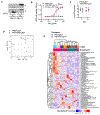Engineered Escherichia coli for the in situ secretion of therapeutic nanobodies in the gut
- PMID: 37003258
- PMCID: PMC10101937
- DOI: 10.1016/j.chom.2023.03.007
Engineered Escherichia coli for the in situ secretion of therapeutic nanobodies in the gut
Abstract
Drug platforms that enable the directed delivery of therapeutics to sites of diseases to maximize efficacy and limit off-target effects are needed. Here, we report the development of PROT3EcT, a suite of commensal Escherichia coli engineered to secrete proteins directly into their surroundings. These bacteria consist of three modular components: a modified bacterial protein secretion system, the associated regulatable transcriptional activator, and a secreted therapeutic payload. PROT3EcT secrete functional single-domain antibodies, nanobodies (Nbs), and stably colonize and maintain an active secretion system within the intestines of mice. Furthermore, a single prophylactic dose of a variant of PROT3EcT that secretes a tumor necrosis factor-alpha (TNF-α)-neutralizing Nb is sufficient to ablate pro-inflammatory TNF levels and prevent the development of injury and inflammation in a chemically induced model of colitis. This work lays the foundation for developing PROT3EcT as a platform for the treatment of gastrointestinal-based diseases.
Keywords: TNF; colitis; designer probiotic; engineered E. coli; in situ drug delivery; inflammatory bowel disease; live biotherapeutic; nanobody; type III secretion.
Copyright © 2023 Elsevier Inc. All rights reserved.
Conflict of interest statement
Declaration of interests C.F.L is on the scientific advisory board (SAB) for and A.Z.R. is an employee and has equity at Synlogic Therapeutics. J.P.L is an employee at AdAlta Ltd. W.S.G. is on the SABs of Kintai Therapeutics, SanaRx, Evelo Biosciences, and Tenza. F.I.S. is a co-founder and shareholder of Odyssey Therapeutics and a shareholder of IFM Therapeutics. C.B.S is a scientific advisor, and V.K. is the CEO and co-founder of Vicero, Inc. PROT(3)EcT is the subject of US Patent no. 9,951,340 and US Patent 10,702,559, both filed by Massachusetts General Hospital.
Figures






References
MeSH terms
Substances
Grants and funding
LinkOut - more resources
Full Text Sources
Research Materials
Miscellaneous

